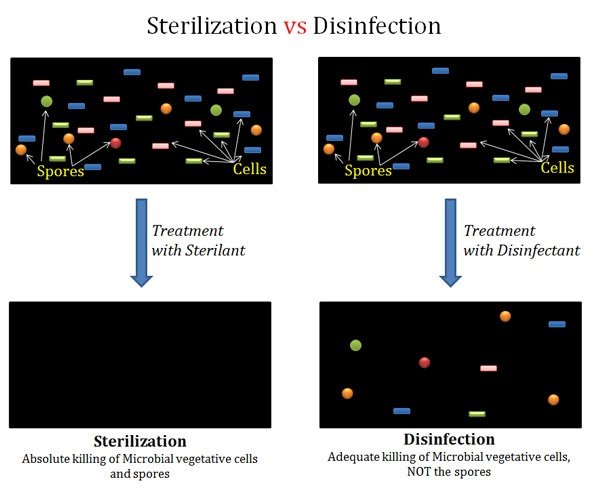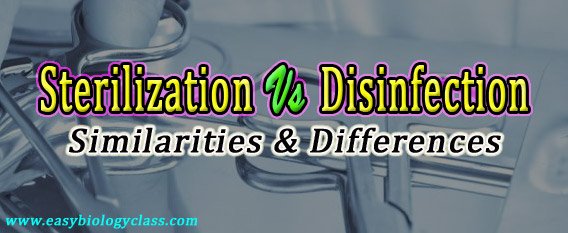Sterilization vs Disinfection
Disinfection vs Sterilization: Microbes are present in almost all types of habitats. They are so ubiquitous that the presence of many microbes causes undesirable consequences such as food spoilage and diseases. Thus in many situations, it is mandatory to kill the microbes or inhibit their growth to minimize or completely nullify their destructive activities. Sterilization and Disinfection are the two commonly used methods to kill or inhibit the growth of microbes to avoid their undesirable consequences.
More in Microbiology: Lecture Notes, PPTs, MCQs
Sterilization is a process by which an article, surface or medium is freed of all living microorganisms either in vegetative or in spore state. The materials that have been subjected to the process is said to be Sterile. Usually, the sterilization process is done by physical agents such as heat, steam or radiation.
Disinfection is the use of chemical agents that destroy pathogenic microorganisms. Disinfection reduces the number of microbes to a minimal level so that it is no longer harmful. Disinfection destroys only vegetative cells, not the spores (endospores and fungal spores)
The present post discusses the Similarities and Differences between Sterilization and Disinfection with a Comparison Table.
Similarities between Sterilization and Disinfection
Ø Both sterilization and disinfection are decontamination processes.
Ø Both kill harmful and harmless microbes.
Ø Both are used to destroy bacteria, fungi, protozoans and viruses.
Ø Both sterilization and disinfection use agents called sterilants or disinfectants respectively.
Difference between Sterilization and Disinfection
Sl. No. Sterilization Disinfection
1 Sterilization is the freeing of articles, surface or medium from all living microorganisms. Disinfection is the process that reduced the number microbes to a minimal level so that it is no longer harmful.
2 Kills both vegetative cells and spores Kill only vegetative cells. Sores are not killed.
3 Used to completely remove microbes from objects of instruments coming direct contact with a break in skin or mucous membrane. Used to reduce microbes from objects or instrument coming direct contact with intact tissue or mucous membrane.
4 Examples: Sterilization of surgical instruments by autoclaving. Example: Disinfecting urinals, gastroscopes. pasteurization etc.
5 Ensure complete elimination of microbes. Complete elimination of microbes is not ensured. Only the population size is reduced.
6 Provide absolute or extreme cleanliness. Provide only adequate cleanliness.
7 Usually, physical methods are used in sterilization. Usually, chemical methods are used in disinfection.
8 Sterilizing agents (sterilants): dry heat, steam, radiation, filtration Disinfecting agents (disinfectants): Phenol, Chlorine, Iodine, Alcohol, Hydrogen peroxide
9 Sterilization is usually used for medical or research purposes. Disinfection is usually used in daily life processes.
You might also like…
@. Bacterial Vegetative Cells vs Endospores


